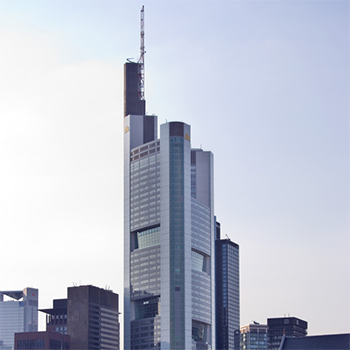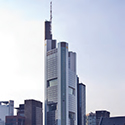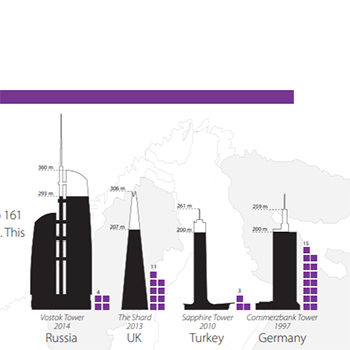Filter by
You must be a CTBUH Member to view this resource.
Commerzbank Tower
Commerzbank Zentrale
Building
Completed, 1997
60311
office
composite
259.0 m / 850 ft
56
2
25
108,000 m² / 1,162,502 ft²
You must be a CTBUH Member to view this resource.
You must be a CTBUH Member to view this resource.
Usually involved in the front end design, with a "typical" condition being that of a leadership role through either Schematic Design or Design Development, and then a monitoring role through the CD and CA phases.
Other Consultant refers to other organizations which provided significant consultation services for a building project (e.g. wind consultants, environmental consultants, fire and life safety consultants, etc).
Material Supplier refers to organizations which supplied significant systems/materials for a building project (e.g. elevator suppliers, facade suppliers, etc).
Material Supplier refers to organizations which supplied significant systems/materials for a building project (e.g. elevator suppliers, facade suppliers, etc).
You must be a CTBUH Member to view this resource.
Usually involved in the front end design, with a "typical" condition being that of a leadership role through either Schematic Design or Design Development, and then a monitoring role through the CD and CA phases.
Usually takes on the balance of the architectural effort not executed by the "Design Architect," typically responsible for the construction documents, conforming to local codes, etc. May often be referred to as "Executive," "Associate," or "Local" Architect, however, for consistency CTBUH uses the term "Architect of Record" exclusively.
The CTBUH lists a project manager when a specific firm has been commissioned to oversee this aspect of a tall building’s design/construction. When the project management efforts are handled by the developer, main contract, or architect, this field will be omitted.
The main contractor is the supervisory contractor of all construction work on a project, management of sub-contractors and vendors, etc. May be referred to as "Construction Manager," however, for consistency CTBUH uses the term "Main Contractor" exclusively.
Other Consultant refers to other organizations which provided significant consultation services for a building project (e.g. wind consultants, environmental consultants, fire and life safety consultants, etc).
Material Supplier refers to organizations which supplied significant systems/materials for a building project (e.g. elevator suppliers, facade suppliers, etc).
Material Supplier refers to organizations which supplied significant systems/materials for a building project (e.g. elevator suppliers, facade suppliers, etc).
CTBUH Meeting Frankfurt
28 November 2016 - Event
CTBUH Releases Study on the Past, Present and Future of the European Skyscraper
1 June 2013 - CTBUH Journal

28 July 2018
Using Height-Relative Variables To Design Tall Buildings
John Jory, Queensland University of Technology
This paper investigates height-variable phenomena in the urban context, and their relevance to the design and performance of tall buildings. It proposes a design approach...

28 July 2018
Using Height-Relative Variables To Design Tall Buildings
This paper investigates height-variable phenomena in the urban context, and their relevance to the design and performance of tall buildings. It proposes a design approach...

01 July 2018
Towards Resource-Generative Skyscrapers
Rapid urbanization, resource depletion, and limited land are further increasing the need for skyscrapers in city centers; therefore, it is imperative to enhance tall building...

01 March 2018
Designing the High-Rise Building from the Inside/Out
For over 100 years, the tall building has largely advanced in technological innovation; however very little has been done in the terms of understanding the...

17 October 2016
Towards Resource Generative Skyscrapers
Rapid urbanization, resource depletion, and limited land are further increasing the need for skyscrapers in city centers; therefore, it is imperative to enhance tall building...

01 June 2013
The Past, Present and Future of the European Skyscraper
There are currently 109 skyscrapers over 150 meters in Europe. This number is set to jump to 161 by the end of 2015, meaning that...

01 May 2011
The Importance of Real Life Data to Support Environmental Claims for Tall Buildings
One of the main causes of energy efficiency failures is LEED rewarding projects for their predictions, but not for proving the savings. The operation of...

13 April 2011
Tall and Urban: An Analysis of Global Population and Tall Buildings
Tall buildings are spreading across the globe at an ever-increasing rate. This study demonstrates the relationship between population and tall buildings across those countries and...

01 February 2009
The Skycourt - A Comparison of Four Case Studies
The effects of industrial capitalism and secularism have not only seen the fall of public man (Sennett 1976) but the slow disintegration of the public...
28 November 2016
A preparatory meeting for the creation of a CTBUH Germany Chapter was held on the 7th floor of the TaunusTurm in Frankfurt, kindly sponsored by Werner Sobek.
1 June 2013
There are currently 109 skyscrapers over 150 meters in Europe. This number is set to jump to 161 by the end of 2015, meaning that there are more than 50 projects in advanced stages of construction.
13 April 2011
Tall buildings are spreading across the globe at an ever-increasing rate. This study demonstrates the relationship between population and tall buildings across those countries and presents information on the average height and age of each country’s tallest buildings.
Subscribe below to receive periodic updates from CTBUH on the latest Tall Building and Urban news and CTBUH initiatives, including our monthly newsletter. Fields with a red asterisk (*) next to them are required.
View our privacy policy